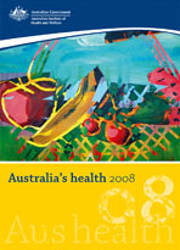Summary
This section presents selected findings from the report. Also, each chapter from 2 to 8 begins with its own lists of key points. Please refer to the index at the back for more detail on these topics.
General
Life expectancy and death
- Australians enjoy one of the highest life expectancies in the world, at 81.4 years— second only to Japan.
- Death rates are falling for many of our leading health concerns, such as cancer, heart disease, strokes, injury and asthma.
- Cardiovascular diseases, cancers and respiratory diseases remain the leading causes of death overall.
- Injury is the most common cause of death in the first half of life.
Health, disease and disability
- Heart attack rates are falling and survival from the attacks is improving.
- Survival is improving for cancers overall.
- Asthma has become less common among children and young adults.
- Diabetes is becoming more common—prevalence at least doubling in the past two decades.
- Because of severe disability, over 1 million Australians need assistance with the core life activities of mobility, self-care or communication.
Health risks
- Tobacco smoking offers the greatest scope for prevention, closely followed by high blood pressure and overweight/obesity.
- Australia’s level of smoking continues to fall and is among the lowest for OECD countries.
- Illicit drug use in Australia is generally declining, including the use of methamphetamine (the drug group that includes ‘ice’).
- The vaccination coverage of children is very high and continues to increase.
- Unsafe sexual practices continue, with generally increasing rates of sexually transmitted infections.
- About 7.4 million Australian adults were overweight in 2004–05, with over a third of those being obese (based on self reports).
Population groups
Mothers and babies
- Caesarean section rates increased from 18% in 1991 to 30% in 2005.
- Aboriginal and Torres Strait Islander babies are about twice as likely as other babies to be low birthweight or pre-term.
Children and young people
- Death rates among children and young people more than halved in the two decades to 2005, largely because of fewer injury-related deaths.
- Close to 3 in 10 children and young people are overweight or obese.
People aged 25–64 years
- The most common causes of death among this group are coronary heart disease for males (16% of their deaths) and breast cancer for females (15%).
Older people
- At age 65 years, Australian males can now expect to live to about 83 years and females to 86—about 6 years more than their counterparts a century ago.
- For older Australians, the most prominent health conditions in terms of death and hospitalisation are heart disease, stroke and cancer.
Socioeconomically disadvantaged people
- Compared with those who have social and economic advantages, disadvantaged Australians are more likely to have shorter lives, higher levels of disease risk factors and lower use of preventive health services.
Aboriginal and Torres Strait Islander peoples
- Indigenous people are generally less healthy than other Australians, die at much younger ages, have more disability and a lower quality of life.
- Despite some improvements in Indigenous death rates, the overall gap between Indigenous and non-Indigenous rates appears to be widening.
- However, the gap in death rates between Indigenous infants and other Australian infants is narrowing.
People in rural and remote areas
- People living in rural and remote areas tend to have shorter lives and higher levels of illness and disease risk factors than those in urban areas.
Prisoners
- Prison inmates tend to have poor mental health and high levels of health risk behaviours, such as drug and alcohol use, smoking, and unsafe sexual practices.
Overseas-born people
- Most migrants enjoy health that is equal to or better than that of the Australian-born population—generally with lower rates of death, hospitalisation, disability and disease risk factors.
Australian Defence Force members and veterans
- Death rates for Australian Defence Force members are lower than the general community’s for overall mortality, cancer, cardiovascular disease, assault and suicide.
- Veterans tend to have poorer mental health than the general community, with the prevalence of mental health problems being closely related to the degree of combat exposure.
Health services
- In 2005–06, less than 2% of health expenditure was for preventive services or health promotion.
- About 85% of Australians visit a doctor at least once a year.
- Almost 1 in 9 GP encounters involves mental health-related problems—mostly depression, anxiety and sleep disturbance.
- Ambulances attended over 2.5 million incidents in Australia in 2005–06, of which 38% were emergency incidents.
- For the year 2005–06, over 9% of hospital admissions were considered potentially preventable.
Health workforce
- Health is a growing sector—between 2001 and 2006, the 23% growth in numbers employed in health occupations was almost double that for all occupations.
- The profile of the health workforce continues to age—the proportion of those aged 55 years and over was 16% in 2006 compared with 12% in 2001.
- Compared with major cities, remote areas have less than half the supply of medical practitioners and dentists (number of ‘full-time equivalents’ per 100,000 population).
- Comparing 2005 with 1997, the overall supply of primary care doctors (mostly general practitioners) was about 9% lower in 2005—but in remote areas the supply was 15% higher.
Health expenditure
- Australia spent 1 in every 11 dollars on health in 2005–06, equalling $86.9 billion, 9.0% of gross domestic product (GDP).
- As a share of its GDP, Australia spent more in 2005 than the United Kingdom (8.3%), a similar amount to Italy (8.9%) and much less than the United States (15.3%).
- Health spending per person was 45% more in 2005–06 than a decade before, even after adjusting for inflation.
- For Indigenous Australians in 2004–05, health spending per person was 17% higher than for other Australians.
- The spending on medications increased by 1.6% between 2004–05 and 2005–06—much less than the average increase of 8.6% per year in the decade before.



